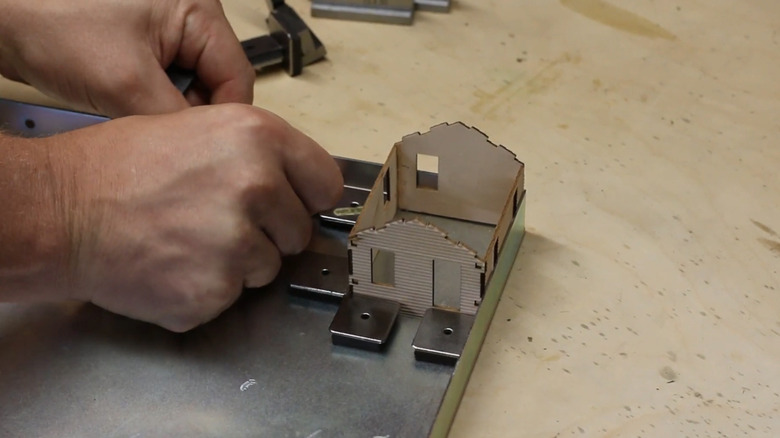The Crafty DIY Trend That Is All The Rage In 2025
We may receive a commission on purchases made from links.
It's in our nature to adore tiny things, and it's impressive when people can make things realistic on a tiny scale. So arises the recent trend of building miniaturized interiors, in which crafters take up the X-Acto and toothpick and do battle with the limitations of eyesight and motor function. This hobby is taking off, driving up the foot traffic at those DIY craft stores you used to think of as places to buy fabric and artificial flowers. The result, as anyone can plainly see with their reading glasses on, is an immersive, little world of kitchens, beds, bookshelves, and welcome mats that only giants ever come home to.
There's not much new in miniatures, of course. Dollhouses of every scale and complexity have been around at least since the 17th century, and they have often been made for, and built by, adults. Miniatures vary in complexity — to say nothing of expense — from build-it-yourself kits from hobby shops such as Michael's to extensive sets built for major motion pictures. Silver wire birdcages might be handcrafted while components for games might be 3D printed, not to mention the detailed, staggeringly large in scope worlds built for model train aficionados and devotees of radio-controlled trucks and tractors.
There's more to miniatures than tiny interiors
The typical miniature interior is a house, room, or scene, often contained in a wooden box of perhaps 1 cubic foot. It has doors that might or might not open onto little verandas, entry hallways, or, best of all, little workshops where minature people might build their own dollhouse within the dollhouse (or so we like to imagine). It's a fun if not time-consuming way to turn an old bookcase or nightstand into an adorable dollhouse.
But, "miniatures" is a concept that's hard to nail down because it contains multitudes: Dollhouses, game pieces, model railroads, figurines, ceramic Christmas villages, and many others. What most have in common is that they attempt some degree of realism or, if representing a fictional world, some degree of fidelity to the original. The realism doesn't have to be absolute, but it should be more than notional. Miniature makers tend to get the most oohs and aahs from the hyper-realism of manufactured miniatures or the actual realness of tiny food practitioners. The tiny food trend combines handcrafted and manufactured miniatures with actual working implements and appliances, enabling proportionally god-like hands to enter the frame and prepare actual, edible food... albeit somewhat less than an American-sized portion.
Miniatures aren't difficult to get into (metaphorically)
YouTube can have interesting effects on hobbies: It can expand the number of hobbyists greatly by making instruction and encouragement available to the masses, and it can accelerate a hobby's expansion into new territories such as reality television. It can also reward craftspeople in a fairly niche hobby with millions of views; somewhat more than you're likely to experience at a local craft show.
Video instruction makes the hobby simpler to understand and get started with, but not necessarily an easy hobby to actually do. The seemingly easiest paths are beset with one complication: You still have to create very tiny things. For example, if it seems like cheating to 3D print miniatures, think again; aside from the skill required to model these scenes and objects in the appropriate software, consider how much more frustrating it must be to assemble a miniature PC's components compared with the real thing. Buying prefabricated components, from furnishings to Pringles cans, is also not taboo. Indeed, the Japanese adopted miniatures into its kawaii culture of cuteness via miniaturized cooking, along with an acceptance of prepared ingredients (not including the food itself). Their tiny kitchens are full of things you aren't likely to make, from glass mixing bowls to Lilliputian set pieces that give the kitchen its immersiveness.
The tools you need for making miniatures
You can visit a hobby shop and be making a miniature bookstore this afternoon, complete with working lights and a sleeping cat — probably without spending money on tools, since kits often come with everything you need. Expect to see X-Acto-style craft knives and tweezers, but there are less-obvious gadgets when you get deeper into the world of miniatures that are helpful in miniature-making.
For example, you might not have thought about a scale ruler — which you can download and print or laser-cut for free – to help keep things in proper ratio. Many of these tools, including tweezers, probes, and picks, can be picked up in a kit meant for repairing electronic devices, such as Kaisi's professional electronics repair kit. A magnetic gluing jig, long used in trades that involve welding and grinding, can also serve you well for positioning and gluing parts together. Given the size, don't forget a lighted magnifier such as the Dagirt magnifying glass with light and stand. Some tools that are extremely helpful for miniatures are also generally good things to have around the home. Some are smaller than average when designed for making miniatures, such as a good set of F-clamps and a miter saw, plus tool companies such as Ryobi make battery-powered tools specifically for crafting hobbies. Other broadly useful tools include Dremel-style rotary tools and a set of pin vises (basically, handles for drill bits) to use for work considered too fine to be trusted to an electric drill.

